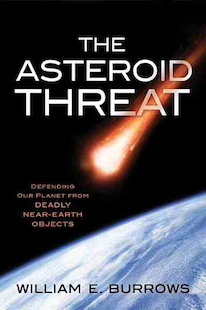By Benjamin Franklin Martin
For more than a century, scientists have recognized the threat to Earth from asteroids and comets. The general population displayed an interest only in the 1980s, with the sensational theory that an impact from either one or the other at Chicxulub on the Yucatan Peninsula led to the extinction of the dinosaurs some 65 million years ago. The spectacular, and ominous, video of the 21 fragments from comet Shoemaker-Levy 9 bombarding the planet Jupiter July 16-22, 1994, focused that interest into anxiety. Then, the meteor that struck near Chelyabinsk in Russia’s Ural Mountains on February 15, 2013, revived those fears and drew international news coverage.
William E. Burrows, Director Emeritus of the Science, Health, and Environmental Reporting Program at New York University and a member of the National Research Council’s Near-Earth Object Survey and Detection Panel, provides a coherent and compelling description of the danger and the requirements to confront it.
An asteroid approximately 50 meters in diameter, similar to the one at Tunguska in Siberia on June 30, 1908, would be a “city-killer,” with the explosive power of 5 megatons; one approximately 150 meters in diameter would be a “country-killer,” with the power of 150 megatons; one of 10 kilometers in diameter would destroy all life on Earth, with the power of 100 million megatons. Thousands of asteroids and some few comets are potentially a grave hazard. One well-known example is the asteroid 99942 Apophis, which has a diameter of 325 meters, approaches Earth every seven years, and will come uncomfortably close in 2036.
The first step in “Planetary Defense” is to locate all the near-Earth asteroids and short-period comets and to track their orbits. If one of them is found to be a potential “impactor,” the second step will be an attempt to alter its orbit. If that effort fails, the third step will be massive evacuation of the projected impact area. Planning has begun. The Action Team 14 of the United Nations International Conference on Near-Earth Objects, the United States National Aeronautics and Space Administration Near-Earth Program Office, and the B612 Foundation are examples at three levels—the world, the national, and the non-governmental.
After invoking science-fiction luminary Arthur C. Clarke’s vision of “Spaceguard” against the peril of “terracide,” Burrows quotes the American Institute of Aeronautics and Astronautics from 1993: “If some day an asteroid does strike the Earth, killing not only the human race but millions of other species as well, and we could have prevented it but did not. . . it will be the greatest abdication in all of human history.”
Benjamin Franklin Martin (ΦΒΚ, Davidson College, 1969) is the Price Professor of History at Louisiana State University and a resident member of the Beta of Louisiana Chapter of Phi Beta Kappa.




